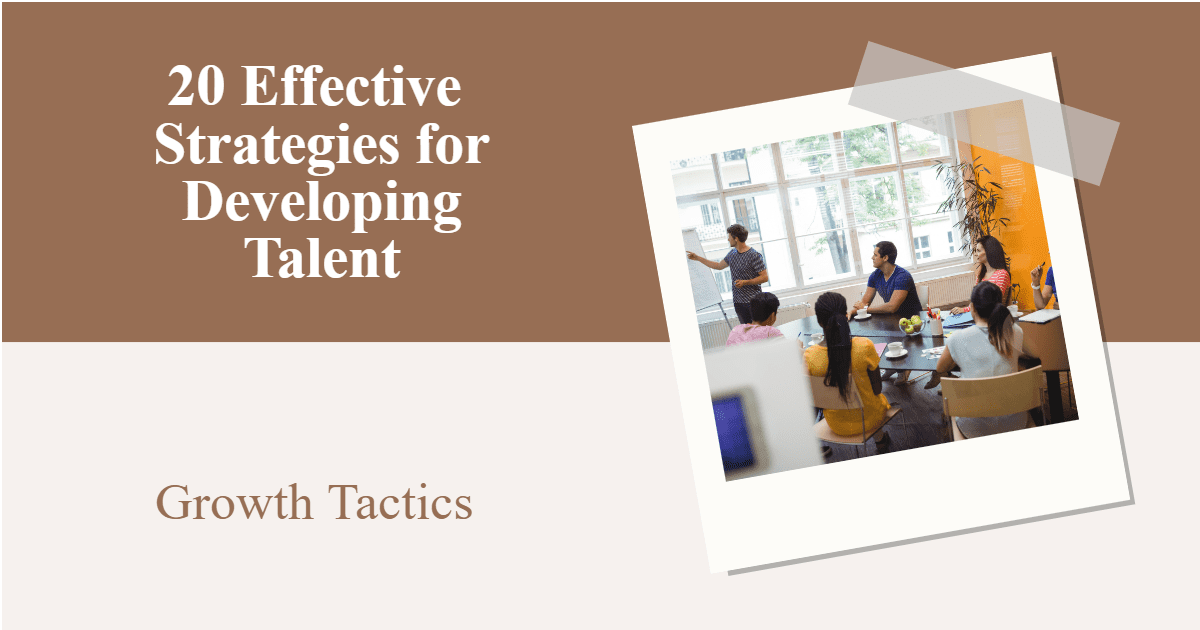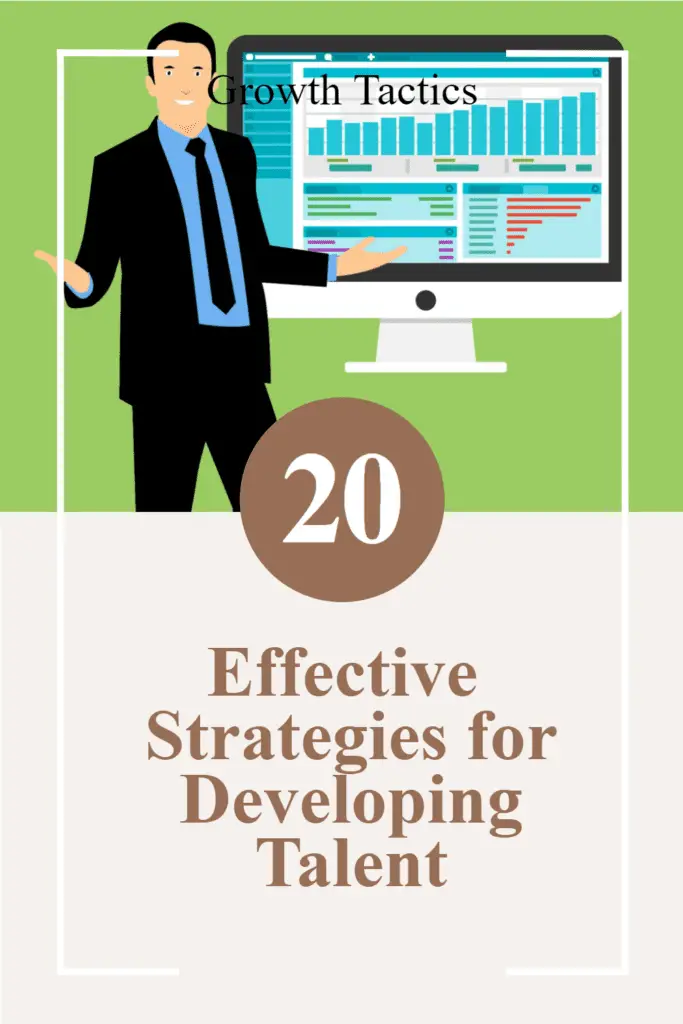In a rapidly evolving business landscape, the key to staying ahead of the pack is no longer just about having the best products or services. It’s about something even more precious and powerful: your people.
That’s right, developing talent properly has become the holy grail of success in today’s cutthroat business world. And let me tell you, the benefits it brings to organizations are nothing short of extraordinary.
Jump To Section
What is Talent Development?
So, what exactly is talent development, you ask? Well, my friend, let me break it down for you in a way that’s as clear as crystal.
Talent development is all about nurturing and cultivating the skills, abilities, and potential of your employees. It’s like being a gardener, tending to a garden of talent within your organization. Just as a skilled gardener knows how to provide the right amount of water, sunlight, and nutrients to help plants flourish, talent development involves creating an environment that allows your employees to thrive.
Think of it as an investment in your people—a deliberate and strategic approach to enable them to grow and reach new heights in their personal and professional lives. It’s about providing them with the resources, opportunities, and support they need to learn, develop, and excel continuously.
Why is Talent Development Important?
Here are the top reasons why talent development is oh-so-important. Let’s count them down, shall we?
-
Building a Dynamic and Engaged Workforce: Talent development creates a workforce that’s fired up and passionately dedicated to their work.
-
Cultivating a Culture of Innovation: It’s all about fostering an environment where curiosity, ideas, and creativity thrive, leading to groundbreaking innovations.
-
Fueling Leadership Potential: Talent development paves the way for identifying and grooming future leaders who will shape the destiny of your organization.
-
Thriving in a Rapidly Changing World: Talent development equips your workforce with the skills and knowledge needed to adapt and thrive amidst constant change.
As you can see, prioritizing talent development isn’t merely an optional extra. It’s a strategic necessity that can transform your organization into a powerhouse of success. So, my friend, let’s get started on this talent development journey and unlock the true potential within your workforce.
Talent Management vs. Talent Development
Welcome to a topic that often causes confusion in the world of HR: talent management vs. talent development. What exactly is the difference between these two terms?
Fear not, my friend, for I am here to unravel the mysteries and shed light on the distinctions between these two crucial concepts. So, let’s dive in and decode the difference between talent management and talent development.
Talent Management: Nurturing the Present
When we talk about talent management, we’re focusing on the here and now. It’s all about attracting, identifying, and retaining the best talent for your organization’s current needs. Think of talent management as the strategic approach to managing your workforce for optimum performance and achieving the organization’s goals.
In talent management, we’re concerned with activities like recruitment, selection, performance management, compensation, and succession planning. It’s about getting the right people in the right roles, ensuring they have the resources they need, and aligning their skills and abilities with the organization’s objectives. Talent management is like the conductor orchestrating a symphony, ensuring all the pieces come together harmoniously for success.
Talent Development: Cultivating the Future
Now, let’s turn our attention to talent development. Talent development is all about developing the capabilities and potential of your employees for future growth and success. It’s about investing in your workforce and empowering them to reach their full potential through learning, training, and skill development programs.
With talent development, we’re nurturing a culture of continuous learning and personal growth. We provide opportunities for employees to expand their knowledge, upgrade their skills, and acquire new competencies. It’s like planting seeds and watching them grow into flourishing trees of talent and expertise within your organization.
Talent development also encompasses leadership development initiatives, mentorship programs, and succession planning to ensure a smooth transition as leaders emerge and retire. It’s about building a pipeline of future leaders who are ready to take the reins and guide the organization toward sustained success.
The Interplay of Talent Management and Talent Development
While talent management and talent development have their own distinct focuses, it’s essential to understand that they are not mutually exclusive. In fact, they go hand in hand, complementing and reinforcing each other.
Talent management sets the stage for talent development by identifying the right individuals with the potential for growth and development. Once the talent has been identified, talent development programs kick in, nurturing their abilities, and providing them with the tools they need to succeed. Talent management and talent development form a powerful partnership, driving your organization towards a bright and prosperous future.
20 Ways to Develop Talent and Empower High-Performing Employees
Let’s dive right into this treasure trove of strategies and unleash greatness within your workforce!
1. Provide Growth Opportunities: Nurturing a Culture of Lifelong Learning
Here’s a golden rule: Constantly nurture a culture that embraces learning and development. Create an environment where your high performers can thrive, and their hunger for knowledge can be appeased.
How? Well, start by offering a smorgasbord of growth opportunities. Consider training workshops, enlightening conferences, and engaging online courses as excellent development opportunities. These avenues will enable your employees to enhance their knowledge and skills, ensuring they stay at the top of their game.
2. Encourage Collaboration: Where Ideas Bloom and Expertise Blossoms
Picture this: A vibrant oasis where ideas flow freely and collaboration is the name of the game. That’s the kind of environment you want to create for your high-performing employees.
Encouraging collaboration allows your team members to harness the power of collective intelligence. They can share ideas, work on projects together, and tap into one another’s expertise. This camaraderie fosters growth and propels everyone forward on their journey of self-improvement.
3. Assign Stretch Assignments: Pushing Boundaries to Ignite Growth
Sometimes, a little nudge is all it takes to unlock untapped potential within your A-team. Enter stretch assignments – projects that push boundaries and challenge your high performers to go beyond their comfort zones.
By assigning stretch assignments, you give your top performers the opportunity to explore new horizons, develop new skills, and grow in ways they never thought possible. It’s like opening a door to a world of endless learning opportunities – a fertile ground for growth and development.
4. Offer Coaching and Mentoring: Wisdom Shared, Success Amplified
Here’s a secret sauce for success: connecting your high-performing employees with experienced mentors who have walked the same path before them. These mentors will provide guidance, support, and valuable insights that can turbocharge the growth of your rockstars.
Coaching and mentoring relationships nurture a culture of continuous improvement. They provide a safe space for your high performers to learn from those who have already made the journey. The wisdom shared in these relationships can elevate their skills and accelerate their progress toward greatness.
5. Foster a Feedback Culture: Building Brilliance, Brick by Brick
One of the most powerful tools you have in your talent development arsenal is feedback. Regularly providing constructive feedback and recognition gives your high performers the fuel they need to continue growing and improving.
Feedback is the cornerstone of a growth mindset. It helps your employees understand their strengths and opportunities for growth. By giving them specific feedback, you provide a roadmap towards excellence and inspire them to keep reaching for the stars.
6. Align Goals with Organizational Objectives: Establishing a Unified Purpose
To unlock the full potential of our top talent, it is essential to help them understand how their individual goals align with the overall goals of the organization. By establishing this alignment, we provide them with a sense of purpose and direction that fuels their motivation and dedication.
When employees see the connection between their personal goals and the organization’s objectives, they realize that their work has a meaningful impact on the larger picture. This realization instills a sense of pride and ownership, driving them to go above and beyond to contribute to the collective success. By regularly communicating the organizational goals and showing how their work directly contributes to achieving those goals, we foster a sense of unity and alignment across the entire team.
7. Provide Autonomy: Unleashing the Power of Decision-Making
Empowering our high-performing employees means giving them the autonomy to make decisions and trusting in their abilities to make impactful choices. By providing them with the freedom to exercise their judgment and expertise, we create an environment that nurtures innovation, ownership, and growth.
When employees have autonomy in decision-making, they feel a sense of responsibility and control over their work. This autonomy not only boosts their confidence but also encourages them to think creatively, take risks, and explore new possibilities. By trusting in their capabilities, we not only foster their individual growth and development but also cultivate a culture that values and celebrates initiative and independent thinking.
8. Recognize and Reward Achievements: Reinforcing Motivation and Dedication
Celebrating the accomplishments of our high performers and rewarding their achievements is a powerful way to reinforce their motivation and dedication. Recognition and rewards serve as tangible expressions of appreciation, acknowledging their hard work and contributions.
When we recognize and reward the achievements of our high-performing employees, we create a positive feedback loop that encourages them to continue striving for excellence. This affirmation not only boosts their confidence but also fosters a sense of fulfillment and job satisfaction. By publicly acknowledging their successes, we also inspire other team members to strive for greatness, creating a culture that values and celebrates exceptional performance.
9. Create a Development Plan: Charting the Path to Growth and Success
Each high performer is unique, with their own goals, strengths, and areas for improvement. By working closely with them to create a personalized development plan, we demonstrate our commitment to their growth and success.
A development plan outlines the specific goals, milestones, and steps needed to achieve their objectives. By collaboratively crafting this roadmap, we provide clarity and guidance, enabling them to progress strategically in their journey of growth. Regular feedback and review sessions can help assess their progress, reassess goals, and adjust the plan as needed, ensuring they stay on track toward their personal and professional development.
10. Offer Job Rotation: Expanding Horizons and Building Versatility
Allowing employees to explore different roles and departments within our organization is a powerful way to broaden their expertise, expose them to new challenges, and promote versatility.
Job rotation provides employees with the opportunity to develop a deep understanding of the organization as a whole. By experiencing different roles and responsibilities, they gain valuable insights into different aspects of our operations, enabling them to identify new skills and interests.
Furthermore, job rotation builds adaptability and resilience. It exposes employees to diverse perspectives, improves their problem-solving abilities, and enhances their ability to collaborate effectively with colleagues from different areas of the organization. This exposure also helps develop future leaders by broadening their understanding of different functions and providing them with a well-rounded skill set.
11. Foster a Culture of Innovation
Encourage your high performers to think creatively, take risks, and challenge the status quo to foster innovation within your organization.
12. Provide Leadership Opportunities
Give high-performing employees the chance to lead projects, teams, or initiatives to develop their leadership skills and expand their horizons.
13. Support Work-Life Balance
Help your high performers maintain a healthy work-life balance by promoting flexible work arrangements and ensuring they recharge and rejuvenate.
14. Invest in Technology and Tools
Equip your high performers with the latest technology and tools that enhance their productivity, efficiency, and ability to deliver exceptional results.
15. Foster a Diverse and Inclusive Environment
Create a workplace that values diversity and inclusion, where high performers feel welcomed, respected, and valued for their unique perspectives.
16. Encourage Networking
Provide opportunities for high-performing employees to network with professionals in their field, both internally and externally, to expand their knowledge and connections.
17. Regularly Evaluate Performance
Conduct regular performance evaluations to assess progress, identify areas for improvement, and recognize the achievements of your high performers.
18. Promote Work-Life Integration
Encourage integration of personal passion and interests into work activities to foster engagement and motivation among high performers.
19. Provide Access to Resources
Ensure high-performing employees have easy access to resources such as research materials, industry reports, and cutting-edge technology.
20. Lead by Example
Showcase your own commitment to talent development strategies, continuous learning, and high performance, serving as a role model for your employees.
There you have it—twenty powerful ways to develop talent and empower those high-performing gems in your organization. Choose the strategies that resonate with you and the unique needs of your workforce. Remember, unlocking their potential is not just beneficial for them but for the success and growth of your entire organization. Let’s embark on this journey of talent development and together witness the extraordinary heights your high performers can achieve!








